In the cryptocurrency world, wanting to turn a capital of 500,000 into 2,000,000 is very common. It's not surprising even if you make 20,000,000! If you have enough funds, earning 1,000,000 is simply an easy task. However, if your capital is really too small, the only assistance I can offer you might just be the strategy of rolling contracts.
5 years without a liquidation, turning 5,000 dollars into 1,000,000: I share my 'winning strategy sheet' with you. 'In just 3 minutes, I'll teach you how to easily turn the exchange into your own cash machine—no need to guess price fluctuations, no need to constantly monitor the market, with zero liquidation record over 5 years, relying on 5,000 dollars in capital to snowball to seven figures, all thanks to just a 'probability strategy sheet'.
In 2017, I entered the cryptocurrency world with just $5,000. Back then, many of my colleagues were wiped out from their contracts, some even mortgaging their homes, ultimately ending up sleeping on overpasses. My account's equity curve, on the other hand, has steadily risen at a 45-degree angle, never experiencing a drawdown exceeding 8% of my principal. I don't rely on insider information, don't try to profit from airdrops, and don't believe in "K-line metaphysics." I simply view the market as a gambling machine, and I'm determined to always be the "casino boss" in control.
Three keys, I will show you today——
Locking in profits and compounding interest: building a "safe fortress" for profits
The moment I place a trade, I immediately set two orders: a take-profit order and a stop-loss order. When profits reach 10% of my principal, I immediately withdraw 50% of the profits, transferring the USDT to a cold wallet for safekeeping, and use the remaining half for rolling positions.
Remember, rolling a position isn't about investing your principal, it's about investing your windfall. This can have two outcomes: If the market continues to rise, you can enjoy the thrill of compounding interest; if the market takes a sharp turn for the worse, you'll only lose half of your profits, leaving your principal intact.
Over the past five years, I've withdrawn my profits 37 times, with the largest single-week withdrawal amount reaching 180,000 U. At one point, the exchange's customer service even suspected me of money laundering and made a video call to verify the situation.Misaligned Position Building: Transforming Retail Investors’ Breakout Points into My “Wealth Code”
I will pay attention to three time periods at the same time: use the daily line to determine the general direction, use the 4-hour line to find the trading range, and make precise attacks on the 15-minute line.
For the same currency, I will place two orders at the same time:
Order A: breakout and chase the rise, the stop loss point is set at the previous low of the daily line;
Order B - short sell with limit price, ambush in the 4-hour overbought area.
The stop-loss for both orders was kept within 1.5% of the principal, but the take-profit target was set at more than 5 times the principal. Because the market fluctuates 80% of the time, with frequent two-way fluctuations, I was able to profit in both directions while others were liquidated.
During the LUNA crash last year, the price fluctuated violently by 90% within 24 hours. I used the long-short double-stop profit strategy to increase my account earnings by 42% in a single day, while other people in the group were still blindly guessing the bottom.Stop-loss means profiteering: small losses lead to big gains
"A second late in setting a stop-loss means your profit is halved"—I view stop-loss orders as my "entry ticket" to the market, trading a small 1.5% loss for a chance to control the market. If the market is positive, I'll use a moving take-profit to keep profits flowing; if the market turns against me, I'll decisively cut my losses and exit.
Long-term data statistics show that my trading win rate is only 38%, but the average profit-to-loss ratio is as high as 4.8:1, and the mathematical expectation is positive 1.9%. This means that for every dollar of risk I take, I can steadily earn $1.9 in profit.
Relying on this strategy, I only need to accurately capture two trend waves every year to easily surpass the returns of all bank wealth management products.
Practical operation:
① Fund slicing: Divide the total funds into 10 parts, use at most 1 part for any order, and hold no more than 3 parts at the same time.
② Emotional cooling: If you lose money on two orders in a row, shut down your computer and go to the gym to prevent “revenge orders”.
③ Income Ladder: Every time your account doubles, withdraw 20% to invest in US Treasuries or gold. This will transform your digital assets into "traditional assets," allowing you to sleep soundly even in a bear market. The method is simple to describe, yet defies human nature. The next time you're tempted to hold onto a position, go all-in, or "add another layer," remember this: "In a casino, they're not afraid of you winning, they're afraid of you quitting. Similarly, in the market, they're not afraid of you making a mistake, they're afraid of you being wiped out and never getting back on your feet."
Copy these three tricks, and starting next week, you can also let the exchange work for you.
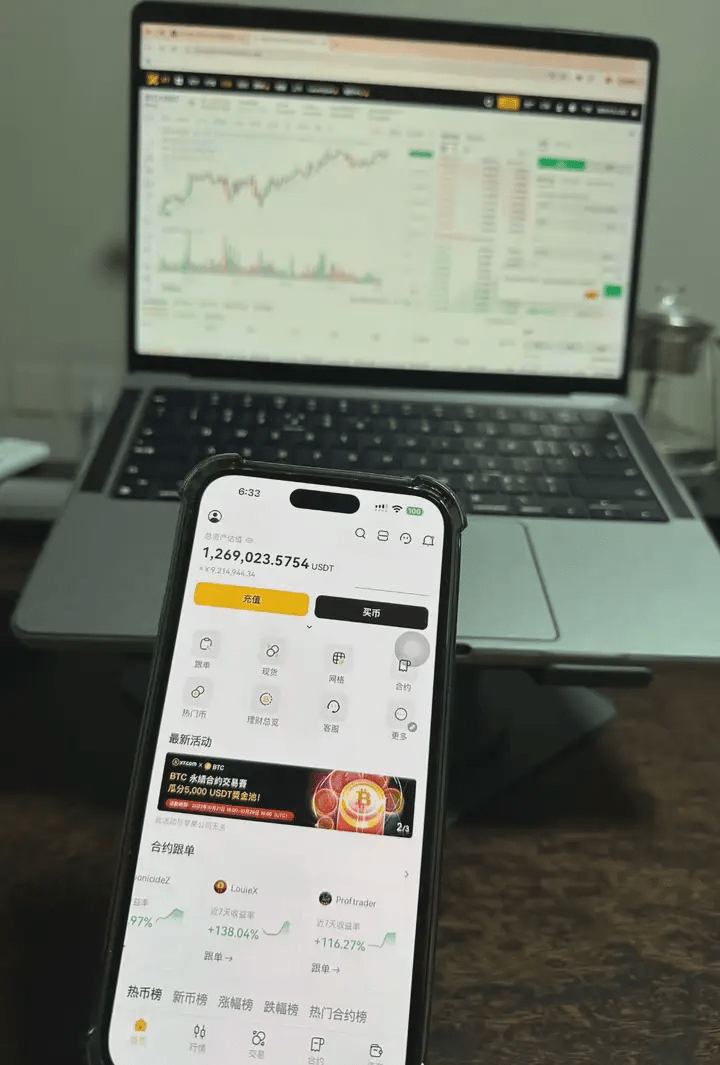
Here’s the practical stuff!
Typically, if a popular coin rises by 30% in a day and you only have a small amount of capital, say $50 to $100, you can choose to go long with 20x leverage at a low price and continue rolling profits (i.e., buying again with the profits).
If the price actually rises by 30% that day, your profit could be between $5,000 and $10,000. For example, recently strong performing currencies like Turbo, Not, and People are very suitable for rolling positions.
However, 20x leverage carries a higher risk, and even a slight market correction could result in losses. Therefore, using 10x leverage may be a better option. Although the expected return will be lower, the margin of error will be significantly higher.
Once you have successfully rolled over, even if something goes wrong later, your loss is limited to the initial $50.
If you have a certain level of market sense or skills and are lucky, then even with only $50, you may be able to double your money.
On the contrary, if you lack luck and skills, you may lose all of it even if you have 500 million in funds.
Therefore, even if you are starting with trial and error, you only need to use $50 to invest instead of blindly investing a large amount of money.
So, how do we roll over?
Learn this rolling method, and when you encounter the next black swan, you will be in trouble!
There are many strategies for rolling positions. Some involve holding a single currency for a long time, while others involve switching between multiple currencies in a short period of time. However, the core logic remains the same, which is based on reinvesting profits.
Rolling positions can continuously magnify profits with no upper limit, especially when operating between multiple currencies, you can make huge profits without too much capital.
Contract rolling is usually based on long positions, as the growth potential of cryptocurrencies is unlimited, especially for some altcoins. The intraday increase of some popular currencies can reach 30-50%, or even 80%. In this case, the returns from rolling can be very impressive.
Taking $50 as an example, using 20x leverage, if the currency held increases by 30% within a day and the position is continuously rolled over during this process, the final profit may be between $6,000 and $10,000. Compared with the $50 principal, this is almost a 200-fold profit.
Of course, a 20x leverage means a lower margin of error. Unless the currency is rising unilaterally, if there is a 4% correction in the market, it is easy to lose all profits (break-even).
Therefore, for beginners, it is recommended to use 5x or 10x leverage, which greatly improves the fault tolerance rate. Generally, strong currencies are unlikely to pull back more than 10% in the market, so the risk is much smaller than 20x leverage.
Of course, the income will also be reduced accordingly. Using 10x leverage and calculating based on a 30% increase, the final income may be around US$2,000-3,000, which is also quite good. It reflects the classic feature of contract trading, "small investment, big returns", which is also the charm of contract trading.
When it comes to futures trading, if you start with a large amount of capital, you'll likely end up losing money unless you have strong technical analysis and risk management skills. Before you develop these skills, the best approach is to use a small amount of capital, such as $50-100, to roll over popular currencies. This is also the easiest way to achieve wealth.
I have been working in the cryptocurrency industry for over 10 years and have identified three main reasons why people lose money:
1. Frequent trading
2. Go all-in on one stock
3. Sell when you make a small profit, and hold on when you suffer a big loss
All cryptocurrency friends who lose money will fall into one of these categories, without exception.
Although you can earn a lot by investing all your money in a single stock, you will also lose more when you encounter risks. Once you lose money, it will be a heavy loss and it will be difficult to recover your investment.
"Sell when you make a small profit and fight to the death when you suffer a big loss" completely goes against the golden rule of investment - let profits run and cut losses.
If you're considering cryptocurrency trading as a secondary source of income, want a piece of the cryptocurrency pie, and are willing to invest the time to grow and learn, don't miss this article. Read it carefully; every point is the essence of the cryptocurrency world. Whether it's a bull market or a bear market, these 12 guiding principles for screening new coins will help you!
1. Low market capitalization is preferred: The circulating market capitalization and total market capitalization should be low, especially for public chains and dApp protocols. Low market capitalization means greater room for growth, preventing project owners from prematurely selling their assets for profit.
2. Track with high potential: The track you choose should have high ceilings and high valuation potential. For reference, consider successful projects, such as ETH and SOL for public chains, and uni and aave for dapps.
3. New Narratives and Value: We prefer projects with new narratives and solving real problems. We prioritize long-term value discovery over short-term speculation, focusing on hot topics such as AI GPU computing power and secure public blockchains.
4. The Concealment of Dark Horse Coins: Hundred-fold Dark Horse Coins are often hidden in areas that are not widely noticed by the public. Avoid the overvalued or normal-valued coins that are widely known online.
5. Liquidity Challenges for Early-Stage Coins: Early-stage 100x-value coins often have poor liquidity and are often found on small exchanges or on-chain. Overcoming these barriers is essential for discovering value.
6. Launch time and market cycle: The best time for tokens to be launched is at the end of a bull market or the beginning of a bear market. The launch and wash period is preferably 6-12 months, with a high circulation rate.
7. Affordable unit price: Low unit price and more zeros after the decimal point are more likely to attract investors, especially in a bull market, low-priced coins are more popular with novices.
8. Prioritize public chains and leading protocols: Public chains and leading protocols on public chains have the greatest potential for making money because of their long life cycle and continuous ecological development.
9. Team and institutional endorsement: The founders, team background, investment institutions and financing amount must be reliable. The participation of well-known teams and institutions increases the credibility of the project.
10. Avoid value investment traps: Do not participate in projects that violate the logic of value investment, such as deflationary tokens, which are often extremely risky.
11. Consider new narratives for old coins: If old coins have strong new narratives that fit in with current market hotspots, you can consider participating, such as those involving AI, metaverse, etc.
The old currency of the domain.
12. Priority is given to track leaders: In the selected track, priority is given to leading projects, which usually have stronger ecological influence and value potential.
Remember, the above rules are guiding principles for screening new currencies, but investing always involves risks, so you need to be cautious with every investment decision.
It took me two years to make 20 million yuan from a principal of 200,000 yuan. I respected the market, had accurate positioning, clear thinking, and used the most stupid cryptocurrency trading strategy, the "Three Black Crows" candlestick pattern to increase the probability of winning in the transaction. I only bought one kind of currency, and the winning rate was 100% and I was never trapped!
It was originally invented by a legendary speculator in the 18th century and later evolved into a global way of observing asset prices.
Japanese rice merchant Homma Munehisa
(Munehisa Homma) came up with the idea of using the so-called candlestick chart
An effective method to interpret market psychology is what we usually call "Japanese candlestick charts".
Early in his speculative career, Munehisa discovered a crucial fact: market price fluctuations were not driven solely by rationality and logic, but were influenced more by human emotions, such as greed and fear. This groundbreaking realization led him to view the market in a whole new way.
Let's look at a candlestick pattern with an oriental flavor - "Three Crows".
Originally, each Japanese candlestick represented one trading day or more.
In the 18th century, collecting daily rice prices
The data will be quite difficult!
Therefore, this article will use traditional time frames – one day and above.
Japanese Candlestick Chart Structure
First, let's briefly introduce candlestick charts.
Each candlestick represents a specific trading cycle and consists of four parts: open, high, low, and close.
The opening price and closing price are the first and last transaction prices of the period respectively.
The High and Low are the highest and lowest prices during the trading hours respectively.
The color of the candle highlights the overall sentiment of the cycle.
If the closing price is higher than the opening price, the cycle is bullish and the candle turns white (international markets usually use green for rising and red for falling; the Chinese market is the opposite, red for rising and green for falling).
Conversely, when the close price is lower than the open price, bears take control and the candlestick turns black.
As the market fluctuates due to supply and demand forces, the shape of the candlesticks also changes.
Let's look at the example below.
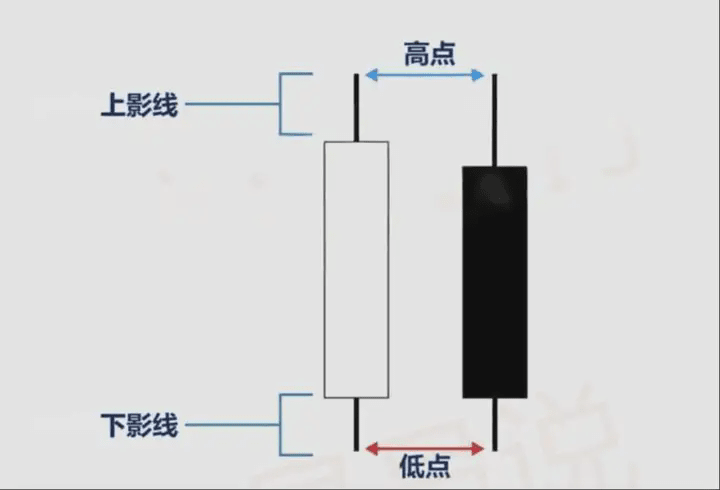
Traders look for candlestick patterns to increase the odds of profitable trades while controlling risk and reward.
The pattern may consist of up to five candlesticks.
What is the Three Crows pattern?
This is a bearish pattern that forms after the market is in an uptrend.
。
Let's look at the properties of this pattern.
◎ It consists of three consecutive bearish candlesticks with large real bodies.
The closing price of each candlestick is lower than the closing price of the previous candlestick.
In a classic pattern, each candlestick opens higher than the previous candlestick's close.
◎ Each candlestick has lower highs and lower lows
Below is a diagram of the Three Crows (see the three candlesticks in the red box).
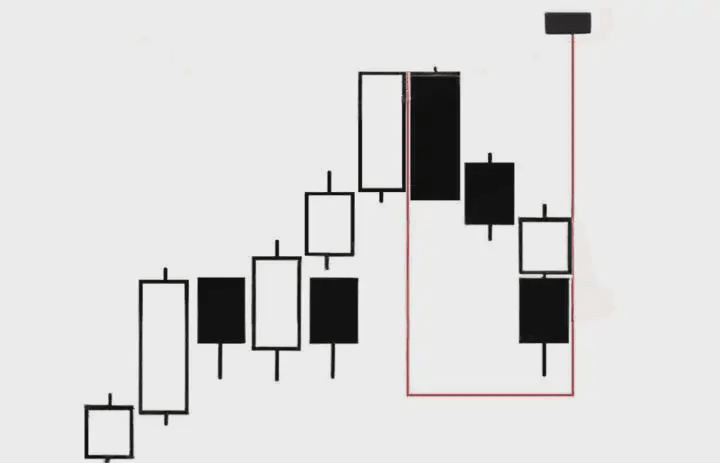
In the stock and futures markets, traders often use volume to confirm the validity of a pattern.
How to do it?
Pro Tip: If the volume during the Three Crows formation is relatively higher than the volume of the previous trend, the pattern is more reliable.
The Psychology Behind the Three Crows
Sharp uptrend pullbacks make investors nervous – like the first candlestick of the Three Crows (see chart below).
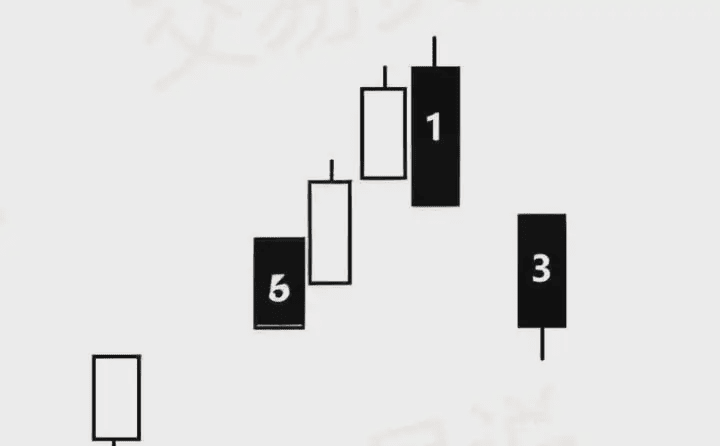
The first move of this pattern usually erases most or all of the gains from the previous uptrend day.
At this point, short-term bulls will look to join the sellers.
Most people who bought at (1) and the day before will suffer losses.
The second day of the pattern (2) opens with a gap up
opening in a positive way as bargain hunters rush to get in on the first trade.
However, the disappointment was significant enough to offset the initial buying pressure.
The gap was quickly filled, with sellers pushing prices lower, resulting in an aggressive bearish daily close.
On the third day, the same scenario repeated itself, frustrating even the most patient remaining bulls.
Therefore, more selling caused the daily candlestick to close as a "black candlestick", completing the three crows pattern.
As a result, short- to medium-term bullish sentiment took a severe hit as too many buyers suffered losses.
1. The Three Crows
While the Three Crows pattern is promising, it is only one part of the candlestick chart.
We should use this pattern in the appropriate environment to get the best probability.
In reality, many of what we see on charts that are considered candlestick "patterns" are nothing more than meaningless puzzle piece shapes.
The factor that causes this difference is the environment in which the morphology occurs.
If you see rain clouds over a rainforest, there's nothing special about it—no climate change or other serious problems.
However, the clouds over the Sahara Desert should also cause people to think and be vigilant.
Identifying an Uptrend
Three Crows appear in a clear uptrend.
How to find an uptrend?
Standard Dow Theory tells us that in an uptrend, prices continually make higher highs (HH) and higher lows (HL).
Furthermore, the trend should last for a considerable amount of time relative to the cycle formed by the Three Crows.
It must be clearly shown that this is an established uptrend and it is undergoing a corrective adjustment in the form of three crows.
The chart below shows an uptrend and three crows (see circled area).
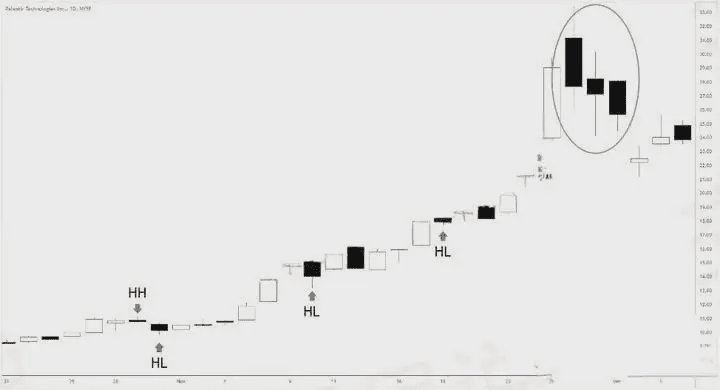
Note the structure of the trend and its duration relative to the Three Crows.
Confirming trends with indicators
Technical tools help us perceive price dynamics more objectively.
You probably have a certain feeling about the market.
However, the indicator's formula will show the market from a statistical point of view.
Consider the moving average; when the price is above the MA, the market is in an uptrend (see chart below).
Conversely, when the price breaks below the MA, a downtrend forms.
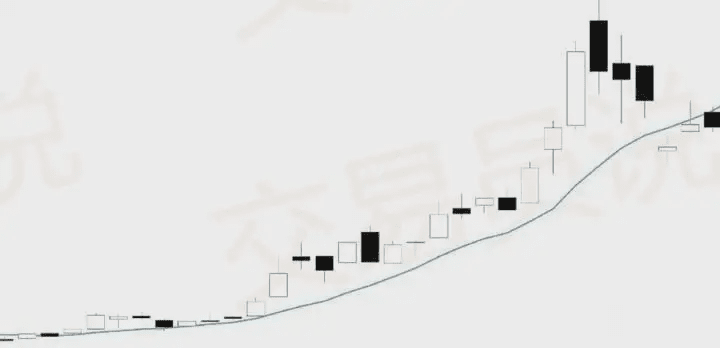
See how those prices are holding above the blue line?
With this confirmation, you can be confident that you are looking for the Three Crows in the right place.
2. Market characteristics
Where you look for the Three Crows is important.
A notable feature of this pattern is the continuous opening of multiple gaps, which is less likely to occur in the 24-hour volatile foreign exchange market.
The classic morphological characteristics described above are more likely to appear in concentrated markets such as stocks or futures.
Why?
Frequent gapping occurs in markets where trading takes place during specific trading sessions – during the exchange’s business hours.
In the Forex market, you can usually only expect significant gaps on Mondays, as the Forex market movement of the week begins first in the New Zealand market.
In the Forex market, the "corrected version" of the Three Crows has no gaps (see the chart below).
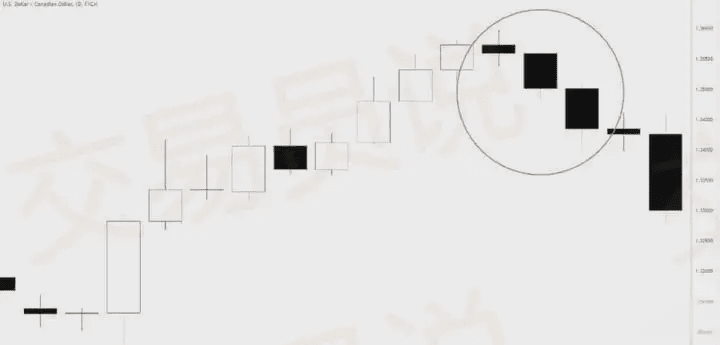
Conversely, each bearish candlestick typically opens at a price close to the previous day’s close (see USDCAD chart above).
The same applies to the cryptocurrency market, as trading can also be conducted on weekends.
Let’s look at the three crows on the Dogecoin daily chart.
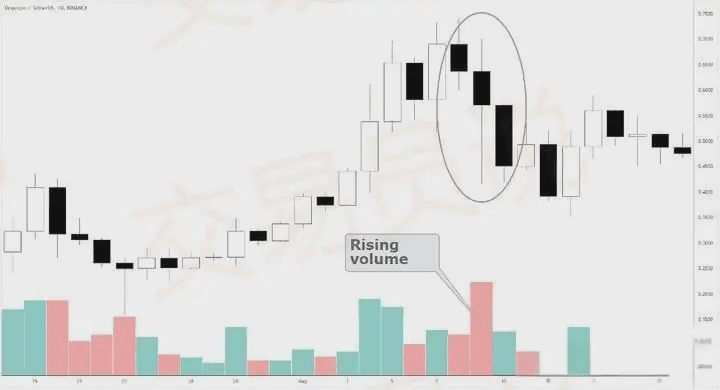
The advantage of cryptocurrencies is that you can use real volume to confirm the validity of the pattern, which is not possible in the forex market.
Note: You can still apply this simplified version of the Three Crows to the stock and futures markets.
The adjusted version is more common and has almost the same meaning.
3. Three Crows Entry Strategy
There are two main entry techniques for this pattern.
Sell at the close of the third candlestick
◎ Enter the market when the low point is broken on the third day
See the picture below.
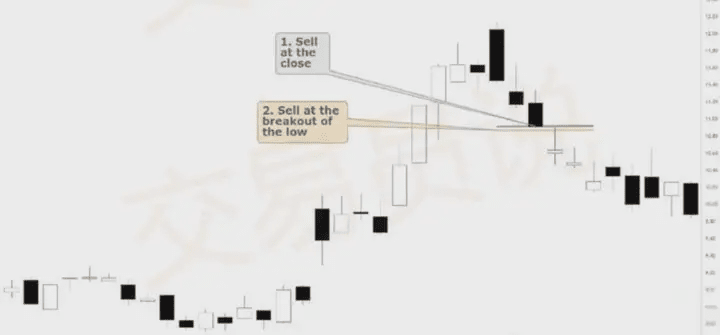
Typically, entering at a breakout point provides a short-term positive boost as long stops are triggered.
Note that in the example above, if you choose the second entry method, you may not be able to execute the transaction due to the gap.
Pro Tip: In US stock trading, you can still try to short in the after-hours or pre-market markets; however, trading volume is usually very low.
You won’t face this problem with Forex, cryptocurrencies, or even futures contracts.
4. Set Risk and Reward
Average returns and win rates depend largely on how you handle stop-loss and profit targets.
Please be careful about this.
A low risk-reward ratio generally provides a higher win rate.
Conversely, a tighter stop loss will reduce your win rate but allow you to achieve multiple risks per trade with a higher return.
Let’s look at a few ways to set stop-loss and take-profit targets for Three Crows.
In the chart below, we have three possible stop-loss placements above the daily high – SL1, SL2, and SL3.
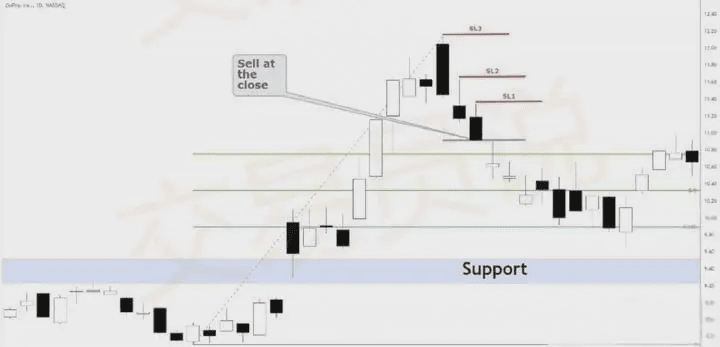
Assume we enter the market at the close of the third day of the pattern.
In this case, we can use the 0.5 and 0.618 Fibonacci retracements as targets.
Ultimately, our goal is to exit at the 9.20-9.50 support area, especially if our protective stop is at SL3.
5. Trading the Three Crows using different time frames
Move to lower time frames to get precise entries with minimal risk.
In the AUDUSD chart below, we have three black crows on the daily chart and resistance on the 1-hour chart “rejecting” the entry.
The stop loss will be placed above the supply zone.
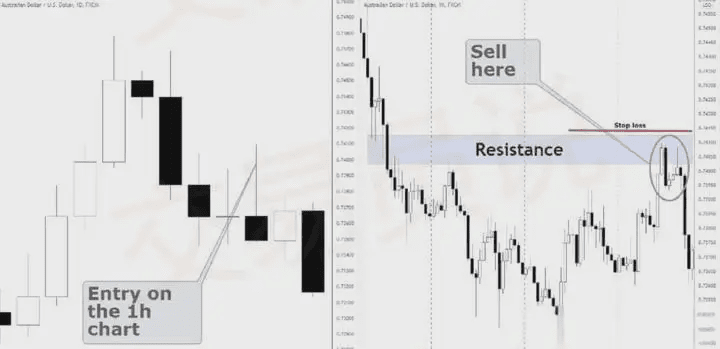
In fact, you can get the highest risk-reward ratio by entering the market on the lower time frames.
However, you should ensure that you have enough time in the day to monitor price action and get enough time to look at the charts to identify these entry opportunities.
6. Integrate Three Crows with other tools
Are these really three crows?
How do we ensure that this pattern has the highest probability of success?
Use other tools along with the Three Crows to confirm the validity of the pattern.
Classic support and resistance, as shown in the previous example, help filter out the best opportunities.
The three most reliable crows appear around these levels.
Indicators that show crossovers and overbought/oversold conditions can also help when patterns emerge.
7. Limitations of the Three Crows Pattern
While the Three Crows pattern is a powerful bearish reversal signal, its limitations must be considered. Here are some basic limitations:
◎ False Signals: Like any other pattern or indicator, the Three Crows pattern can generate false signals. Sometimes the pattern forms, but the price doesn't reverse as expected, resulting in a false signal.
Market Context: Analyzing the broader market context when using the Three Crows pattern is crucial. Factors such as the overall market trend, trading volume, and other technical indicators can provide additional insights and confirmation.
Confirmation Signals: Traders often use confirmation signals or indicators to strengthen their analysis of the Three Crows pattern. Relying solely on this pattern without considering other factors can increase the risk of false signals.
No single tool can consistently and accurately predict market trends. The Three Crows pattern provides a useful early warning of a potential trend reversal, but requires confirmation from other evidence. Exercise caution when trading and adhere to sound analytical and risk management principles.
Summarize
The Three Black Crows pattern is a widely known bearish reversal pattern used by traders to identify potential trend reversals. By understanding the characteristics and limitations of this pattern, traders can make informed decisions and increase the odds of their trading strategies succeeding.
Overall, the Three Crows pattern indicates a weakening trend and suggests lower prices are likely. Identifying this pattern on a chart can indicate a short entry point. However, a surge in volume or a support breakout through the Three Crows pattern often enhances the effectiveness of a shorting strategy. Therefore, when trading the Three Crows pattern, consider the broader market context, use confirmation signals, and employ appropriate risk management techniques.
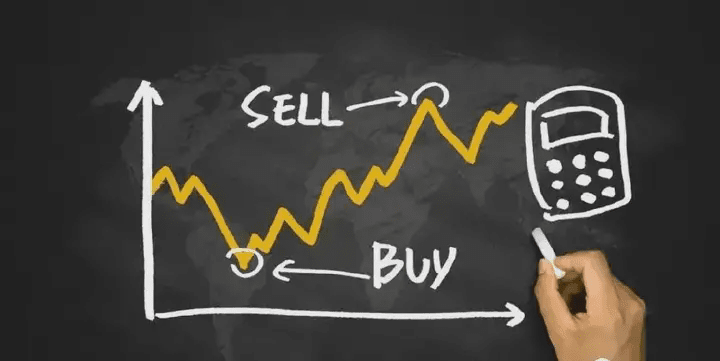
So how do you have a trading system?
Step 1: Look at the trend first
Step 2: Find the key position
Step 3: Find entry signals
Enter the market, take profit, close the position, and leave
Isn’t it simple?
Let me explain it in more detail below.
The status of a disk
There are only three possible outcomes for a market: rising, sideways, or falling.
What is a big market?
Look at a periodic chart of more than 4 hours, such as 4 hours, daily, and weekly
(My personal habit is to watch 4 hours)
Go long on the rise
Go short on a decline
Do not trade when the market is sideways
If the current market is sideways
No need to go on.
If it is a unilateral rise or fall
Please proceed to step 2: Find the key position
Whether the market is rising or falling
It will jump from bottom to top or from top to bottom, one level at a time, like a bouncing ball.
What we have to do is enter the market at the point where it takes off and exit the market at the next landing point.
How to find the precise steps becomes the key
This is what we call the key position (main support and resistance position)
(For more information on how to accurately find the main support and resistance levels, please refer to my previous article)
Step 3: Find the signal
Generally, if you find the market in the big cycle, you should look for trading signals in the small cycle to enter the market.
Everyone is good at different tactics, so just be proficient in one or two.
More importantly, a quick way to develop a trading strategy
A complete trading strategy includes
(1) Subject matter – what is being traded;
(2) Position - how much position is held;
(3) Direction – long or short;
(4) Entry point - at what point to trade;
(5) Stop-loss – when to exit a losing trade;
(6) Take Profit – when to exit a profitable trade;
(7) Countermeasures – how to deal with emergencies;
(8) Backhand - operations after the transaction is completed.
Trend + key position + signal = successful trading
Follow the process to formulate a strategy before each order, I believe you will not lose too much
Develop good habits, and over time, you will find the shortcomings in your trading process
I have been trading in cryptocurrencies for 10 years, going from big losses to big profits. I have summarized 10 iron rules and would like to give a piece of advice to all retail investors! If you want to stay in the cryptocurrency circle for a long time, please read the heartfelt words of this article carefully! Newbies must keep them in mind to be able to navigate the market with ease.
The cryptocurrency world is a world brimming with both opportunities and risks. For beginners, surviving and profiting in this volatile market is a skill that requires continuous learning and practice. 1. Popular coins in a bull market tend to fall the fastest. Hotly hyped coins, especially those with heavily controlled market capitalization, often experience rapid bubble bursts. The more a coin attracts a large number of retail investors chasing its price, the greater the risk.
Just like blowing up a balloon, the bigger it is, the faster it bursts.
Hot coins in a bull market are often the favorites of short-term speculators, but they are also the traps that are most likely to make people lose all their money.
Recommendation: Don’t blindly chase the rise, especially those currencies that have seen huge gains in a short period of time. Stay calm and avoid becoming a "bag holder".
2. The tactics of altcoins are all similar. The way to play altcoins is usually to smash the market first to create panic, then slowly push up the price to attract retail investors, and finally change the method to continue to reap the profits.
This trick has been tried and tested, and novices can easily be cheated.
Suggestion: When it comes to altcoins, you must be mentally prepared, don’t be fooled by short-term gains, and don’t easily increase your holdings.
3. The long-term market trend is upward. Although the cryptocurrency market has experienced sharp fluctuations in the short term, if we look at the long-term trend, the overall trend is upward.
The historical trends of mainstream currencies such as Bitcoin and Ethereum have proven this.
Suggestion: If you are a long-term investor, don’t be scared by short-term ups and downs. Hold on to high-quality assets patiently and time will reward you.
4. No one hypes up coins with potential. Coins with real potential are often unknown at the bottom and few people mention them.
Those coins that are wildly hyped are often tools used by bookmakers to reap profits.
Low-key currencies may quietly explode at some point. Suggestion: Pay more attention to projects with solid technology and reliable teams that have not yet been hyped by the market. They may be the dark horses of the future.
5. Be careful with newly listed coins on exchanges, especially those that experience sharp price fluctuations, which are often traps designed by market makers.
This type of currency usually has no actual value support and is purely for cutting leeks. Suggestion: For new coins, especially those with huge fluctuations in the early stage of listing, be vigilant and do not enter the market easily.
6. Fluctuations are common. Prices drop when you buy them, and rise when you sell them. This is perfectly normal in the cryptocurrency world. Market volatility is extremely high, and short-term fluctuations cannot fully reflect the value of a project.
Recommendation: Maintain a positive attitude and don't panic due to short-term fluctuations. Develop your own investment strategy and stick to it.
7. The most violent rebound does not mean the currency with the most violent rebound is often not the one with real potential, but the one that is hyped up for speculation.
The rise of such currencies usually lacks fundamental support, and they rise quickly and fall quickly.
Recommendation: Don’t be fooled by short-term surges. Currencies with real potential usually have relatively stable fluctuations and an upward long-term trend.
8. Be careful of sudden pullbacks. If the coin you bought suddenly pulls back after a wave of increase, this may be a signal that the dealer has started to sell.
The dealer usually attracts retail investors by raising prices, and then sells at high prices. Recommendation: When encountering a sudden callback, take profit or stop loss in time to avoid becoming the dealer's "takeover hero"
9. Coins that explode in the second half In a bull market, coins that performed generally in the early stages may explode in value by several times or even more in the second half.
This type of currency is like a marathon runner, accumulating energy in the early stages and exerting force in the later stages.
Recommendation: Don’t ignore those currencies that have mediocre performance in the early stage but have solid fundamentals. They may be dark horses in the later stage of the bull market.
10. Coins that have been trading sideways for several months may explode in a bull market. Some coins may trade sideways for several months after experiencing several times the increase.
I am Axin and only do real trading. The team still has positions to move up.


